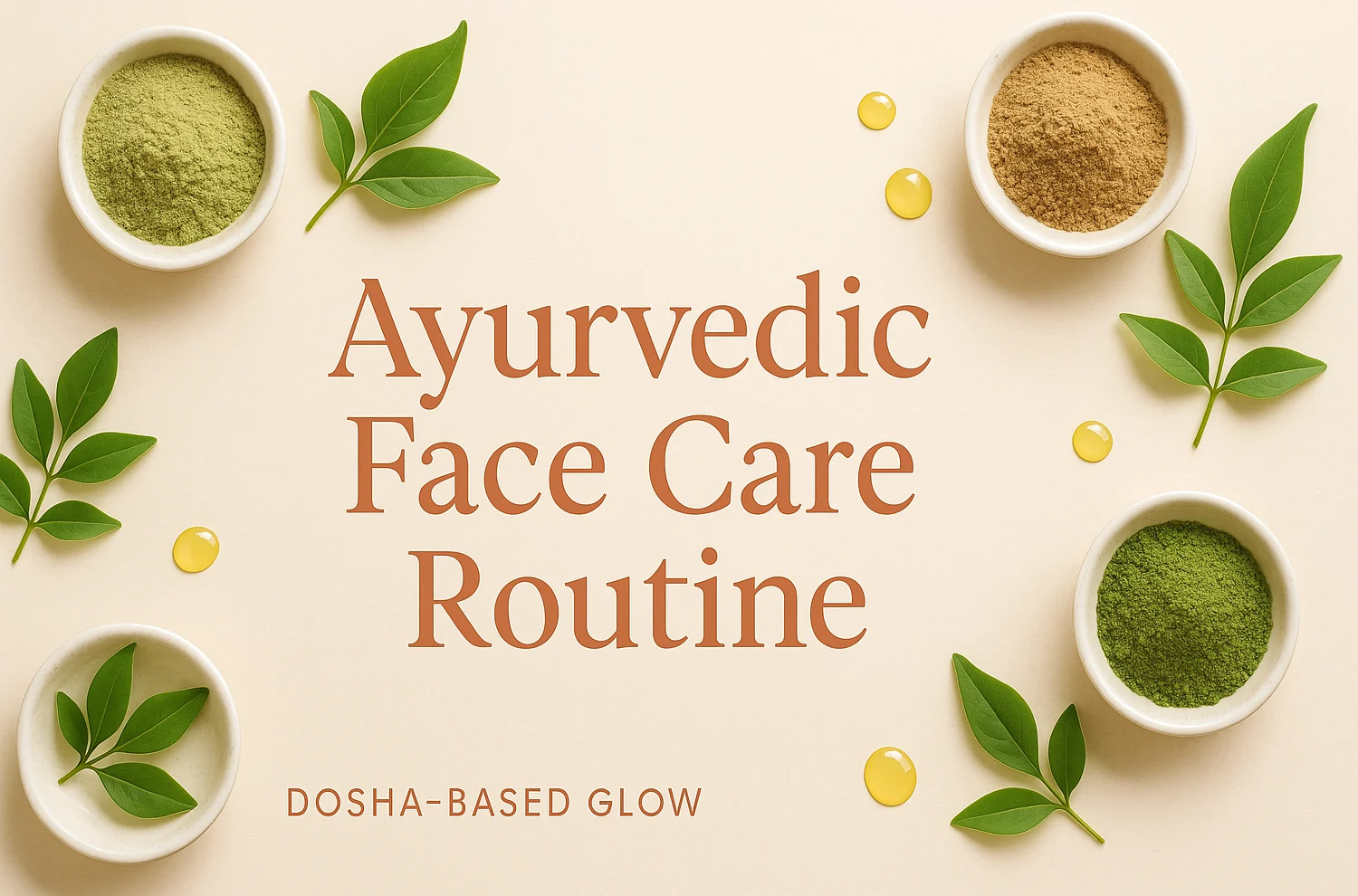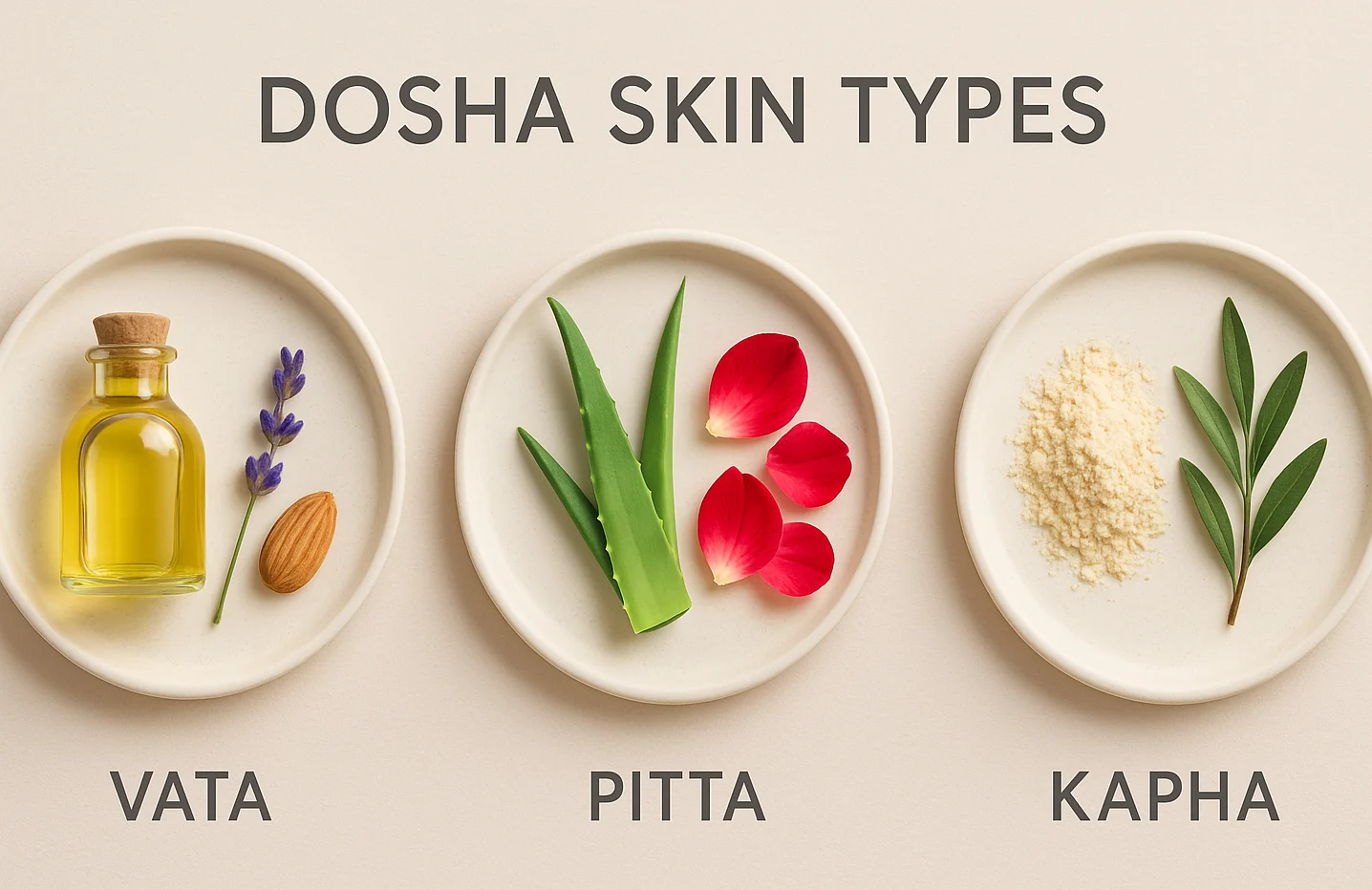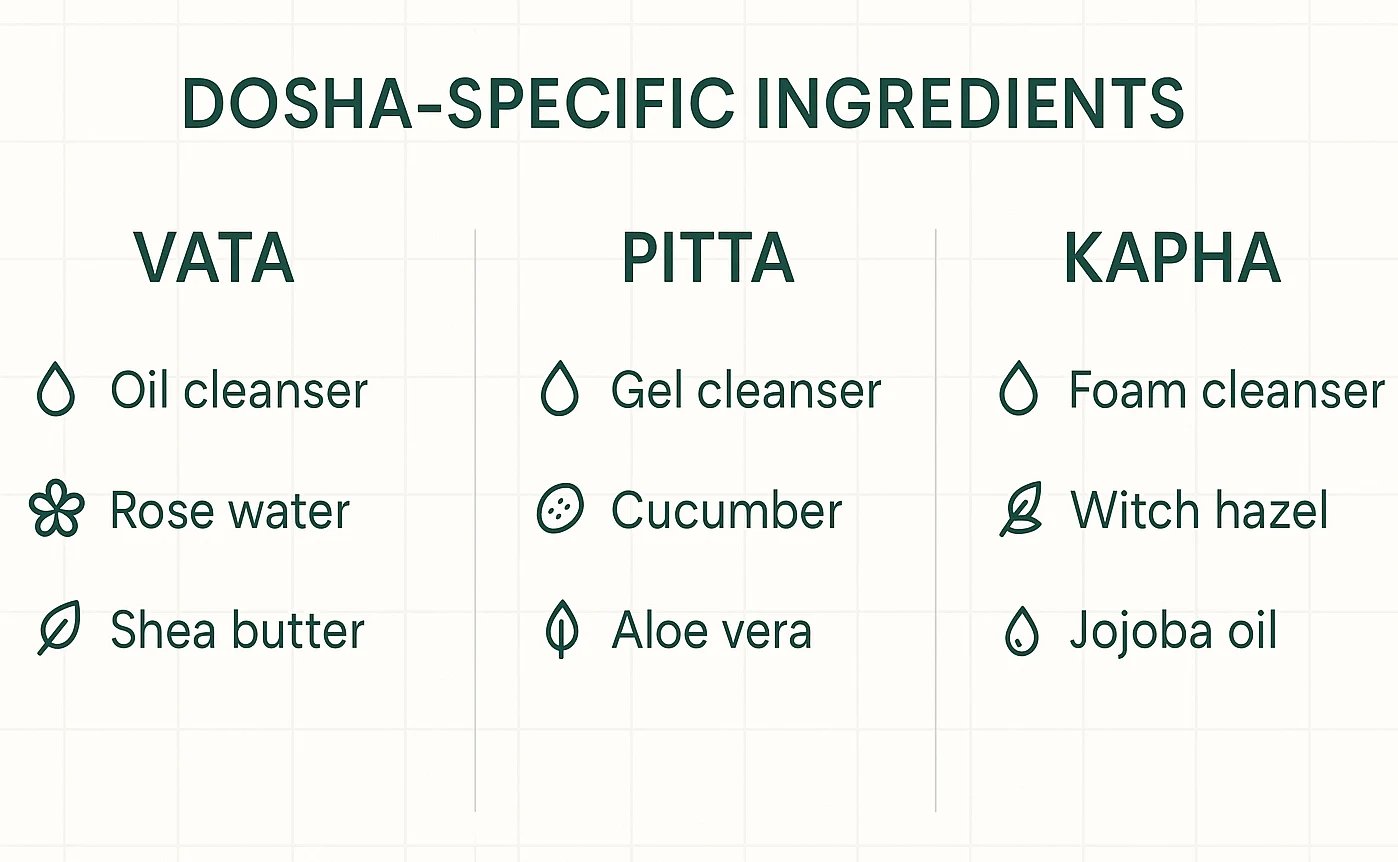
Craving radiant skin without relying on harsh chemicals? With Ayurvedic skincare, you can embrace a glow that comes from balance—not just beauty products. This Ayurvedic face care guide offers a personalized natural face care ritual based on your dosha, using gentle, plant-based ingredients. To see how Ayurvedic skin care fits into a broader lifestyle of well-being, explore our ayurvedic wellness guide.
Discover Your Dosha!This page contains paid/affiliate links. As an Amazon Associate we earn from qualifying purchases, and we may earn commissions from other partners—at no extra cost to you. Links marked with ‘#ad’ are affiliate links, meaning we may earn a commission at no extra cost to you. Learn more.
Table of Contents
- Ayurveda Skincare: Key Takeaways for Glowing Skin
- Understanding Your Skin: The Dosha Connection in Ayurvedic Face Care
- Glossary: Key Ayurvedic Terms for Beginners
- Your Daily Ayurvedic Face Care Ritual: AM & PM
- Find Your Dosha: Take the Skin Dosha Quiz!
- Dosha-Specific Ingredients for Ayurvedic Skincare
- Weekly Treatments for Enhanced Glow
- Seasonal Adjustments for Balanced Skin
- Your Questions on Skincare, Answered
- Start Your Ayurvedic Glow Today
Ayurvedic Skincare: Key Takeaways for Glowing Skin
- Personalized Skincare: Ayurvedic face care customizes routines to your Vata, Pitta, or Kapha dosha for optimal results.
- Dosha Identification: Knowing your dominant dosha guides ingredient and routine choices.
- Holistic Rituals: Daily cleansing, toning, and moisturizing use dosha-specific ingredients, morning and night, incorporating Ayurvedic skincare tips.
- Weekly Treatments: Natural masks, steaming, and oil massages deeply nourish and cleanse.
- Seasonal Adjustments: Adapt your routine to environmental changes for balanced skin.
Understanding Your Skin: The Dosha Connection in Ayurvedic Face Care
In Ayurveda, your mind–body type, or ‘dosha,’ shapes your skin’s needs. The three primary doshas—Vata, Pitta, and Kapha—determine your skin’s characteristics and guide your Ayurveda skincare routine. Most people have a mix, but one or two doshas tend to lead. When your doshas feel balanced, skin often looks healthier; when they’re out of balance, you may notice dryness, breakouts, or extra oil. That’s why figuring out your dominant type is a smart first step in Ayurvedic face care.
For deeper insights, visit the Ayurveda Institute.
Vata Skin (Air & Ether Elements) 🌬️
Vata skin is typically:
- Dry, thin, delicate: Lacks natural oils and moisture.
- Prone to flakiness: Especially in cold, windy weather.
- Early aging: Shows fine lines and wrinkles sooner.
- Cool, rough: Feels sensitive to harsh chemicals.
Think of Vata skin as a delicate flower needing consistent nourishment.
Pitta Skin (Fire & Water Elements) 🔥💧
Pitta skin is often:
- Warm, sensitive: Prone to redness or irritation.
- Fair, freckled: Has a warm, reddish undertone.
- Blemish-prone: Some people find ingredients like neem oil soothing.
- Oily T-zone: May be dry elsewhere.
- Sun-sensitive: Burns easily or develops hyperpigmentation.
Pitta skin, like a fiery spirit, requires cooling, soothing care.
Kapha Skin (Earth & Water Elements) 🌍💧
Kapha skin is usually:
- Thick, oily: Smooth with larger pores.
- Congested: Prone to blackheads or cystic acne.
- Pale, cool: Can appear dull.
- Slow aging: Fewer wrinkles over time.
- Puffy: Retains water, leading to swelling.
Kapha skin resembles fertile ground needing cleansing and stimulation.
Case Study: Sarah, a 32-year-old with Vata skin, switched to Ayurvedic face care after years of dryness. Using sesame oil massages and milk cleansers, she noticed more hydrated, radiant-looking skin within a few weeks—an anecdotal experience; results vary.

Glossary: Key Ayurvedic Terms for Beginners
- Dosha: Your unique mind-body type (Vata, Pitta, Kapha) influencing health and skin.
- Ubtan: A traditional herbal face mask made from flours and herbs, perfect for a gentle at-home routine.
- Abhyanga: Self-massage with warm oil to nourish skin and promote circulation.
- Marma Points: Energy points on the body, massaged to enhance glow.
Your Daily Ayurvedic Face Care Ritual: AM & PM
Ayurveda Beauty Tips: Golden Rules for All Doshas
Follow these Ayurveda beauty tips to support all skin types.
-
Gentle Care: Avoid harsh rubbing or pulling. Two simple tools you can use:
Biodegradable Face Towels (50 ct) — soft, lint-free, great for sensitive skin
Use after cleansing to pat dry without rubbing; ideal for travel and post-workout.
Jade Roller + Gua Sha — de-puffs and boosts circulation in 2–3 minutesKeep in the fridge for extra cooling; glide gently over serum for better absorption.
- Listen to Your Skin: Adjust ingredients based on daily and seasonal skin needs.
- Holistic Health: Diet and lifestyle impact your skin.
- Natural Ingredients: Choose fresh, plant-based, organic options.
Morning Routine: Wake Up Your Glow ☀️
Start your day with Ayurvedic face care to refresh your skin, remove overnight impurities, and protect it.
- Cleansing (Shodhana):
- Vata: Use creamy cleansers like raw milk or an almond oil–honey blend with lukewarm water to hydrate.
- Pitta: Opt for cooling cleansers like Himalaya Purifying Neem Face Wash for normal-to-oily, redness-prone skin.
- Kapha: Choose stimulating cleansers (chickpea flour, tea tree) with warm water to remove oil.
- Toning (Tarpana):
- Vata: Hydrate with SVA Organics Rose Water or lavender hydrosol to soothe.
- Pitta: Use cooling toners like aloe or alcohol-free witch hazel, such as Leven Rose Witch Hazel Toner for a gentle option.
- Kapha: Select astringent toners (witch hazel, diluted apple cider vinegar) to reduce the look of pores.
- Moisturizing & Protection (Poshana & Raksha):
- Vata: Use rich oils or creams for deep hydration; almond oil works well in cooler months.
- Pitta: Soothe with a light gel like Seven Minerals Organic Aloe Vera Gel.
- Pitta (continued): Then finish with mineral SPF, such as Babo Botanicals SPF 50.
- Kapha: Choose non-comedogenic oils, like a few drops of Yoken Pure Jojoba Oil, which absorbs quickly without heaviness.
Tip: Apply products to slightly damp skin to help lock in moisture — a small step that makes Ayurvedic face care feel extra soothing.
Evening Routine: Repair & Rejuvenate 🌙
Remove the day’s impurities and nourish your skin overnight.
- Double Cleansing (Deeper Shodhana): For all doshas, start with an oil-based cleanse (jojoba, almond) to remove makeup, followed by your dosha-specific morning cleanser.
- Toning (Tarpana): Reapply your dosha-specific toner to refresh skin.
- Treatment & Oil Massage (Abhyanga):
- Vata: Massage with warm sesame or a few drops of PURA D’OR Sweet Almond Oil for 5–10 minutes to hydrate.
- Pitta: Use cooling oils (coconut, sunflower) for 5 minutes to calm; spot-treat congestion with Kate Blanc Neem Oil.
- Kapha: Apply light jojoba or grapeseed oil with firm strokes for 5–7 minutes to invigorate.
- Optional Treatment: For tone/texture support, press in 1–2 drops of PURA D’OR Rosehip Seed Oil before moisturizer.
- Moisturizing (Poshana): Seal with a light dosha-specific cream, if needed, after oil massage.
Find Your Dosha: Take the Skin Dosha Quiz!
Discover your dominant dosha to personalize your Ayurvedic face care routine with this quick quiz.
Your Skin Dosha Quiz
Select an answer to reveal your dosha.
Question 1/5
1. How does your skin typically feel?
2. What is your general body frame?
3. How do you react to hot weather and sun exposure?
4. Describe your hair type:
5. How is your digestion and appetite?
Your Ayurvedic Skin Dosha:
Dosha-Specific Ingredients for Ayurvedic Skincare
These staples anchor natural face care across all doshas.
| Dosha | Cleansers | Toners | Moisturizers | Key Herbs | Avoid |
|---|---|---|---|---|---|
| Vata | Creamy, milk-based, honey, almond oil | Rose water, lavender hydrosol | Sesame, avocado oil, shea butter | Frankincense, ashwagandha | Astringents, alcohol-based products |
| Pitta | Rose water, aloe vera, neem | Aloe vera juice, witch hazel | Coconut oil, sunflower oil, aloe vera gel | Neem, sandalwood, turmeric | Hot water, acids |
| Kapha | Chickpea flour, tea tree | Witch hazel, apple cider vinegar | Jojoba, grapeseed, aloe gel | Neem, turmeric, ginger | Heavy oils, dairy |

Weekly Treatments for Enhanced Glow
Complement your daily Ayurvedic face care with weekly rituals for deeper natural face care. You can also explore herbs like manjistha to further support skin health.
Ubtan Masks (Ayurvedic Face Packs)
- Base: Chickpea flour, oat flour.
- Liquid: Milk (Vata), aloe vera (Pitta), rose water (Kapha).
- Add-ins:
- Vata: Turmeric, almond oil, rose petals.
- Pitta: Sandalwood, neem, turmeric.
- Kapha: Lemon peel, ginger, honey.
- Directions: Mix into a paste, apply for 10–15 minutes, rub off, then rinse.
Frequency: 1–2×/week.
Facial Steaming (Swedana)
Steam to help loosen buildup—skip hot steam if your skin is reactive—enhancing your skincare ritual.
- Boil water, add herbs (lavender for Vata, rose for Pitta, eucalyptus for Kapha).
- Steam for 5–10 minutes under a towel.
Frequency: 1×/week. Caution: Pitta types may want to avoid excessive heat.
Marma Point Massage
Massage energy points to support relaxation and a healthy-looking glow.
- Points: Between eyebrows, temples, cheeks.
- Method: Use fingertips with oil, 5 minutes.

Optional: Deeper Testing
If you’re dealing with recurring redness, acne flares, or rosacea-like sensitivity, it can be helpful to look at whole-body inflammation alongside your skincare. Consider at-home testing and then adjust your routine with your dosha in mind.
Your Questions on Skincare, Answered
Start Your Ayurvedic Glow Today
Transitioning to a holistic skincare ritual rooted in Ayurveda is a journey of self-discovery. By embracing your dosha, choosing natural ingredients, and practicing mindful rituals, you’ll unlock radiant skin and deeper well-being. Begin now, and let your natural glow shine!
Disclaimer: This content is for informational purposes only and not a substitute for professional advice. Always read product labels, follow manufacturer directions, and perform a patch test before use. Discontinue if irritation occurs. Consult a healthcare professional if you have medical conditions, allergies, are pregnant/nursing, or take medications.


